Impact of Human Resource Planning in IT and Communications
VerifiedAdded on 2020/03/16
|22
|4591
|38
Report
AI Summary
This report examines the impacts of Human Resource Planning (HRP) on the organizational performance of the Department of IT and Communications in Australia. The study explores the importance of HRP, strategic HRP, and its methodologies, using a case study approach. It investigates the effectiveness of HRP policies and practices, identifies challenges in implementation, and analyzes the relationship between HRP and employee productivity and organizational success. The research includes a review of existing literature, a theoretical framework, and research hypotheses to determine how HRP affects the department's ability to meet its goals. The project also presents a Gantt chart and budget considerations for the research, offering valuable insights for organizations seeking to improve their HRP strategies and enhance overall performance. The findings will benefit students, organizations, and policymakers by providing insights into the impact of HRP on IT departments.
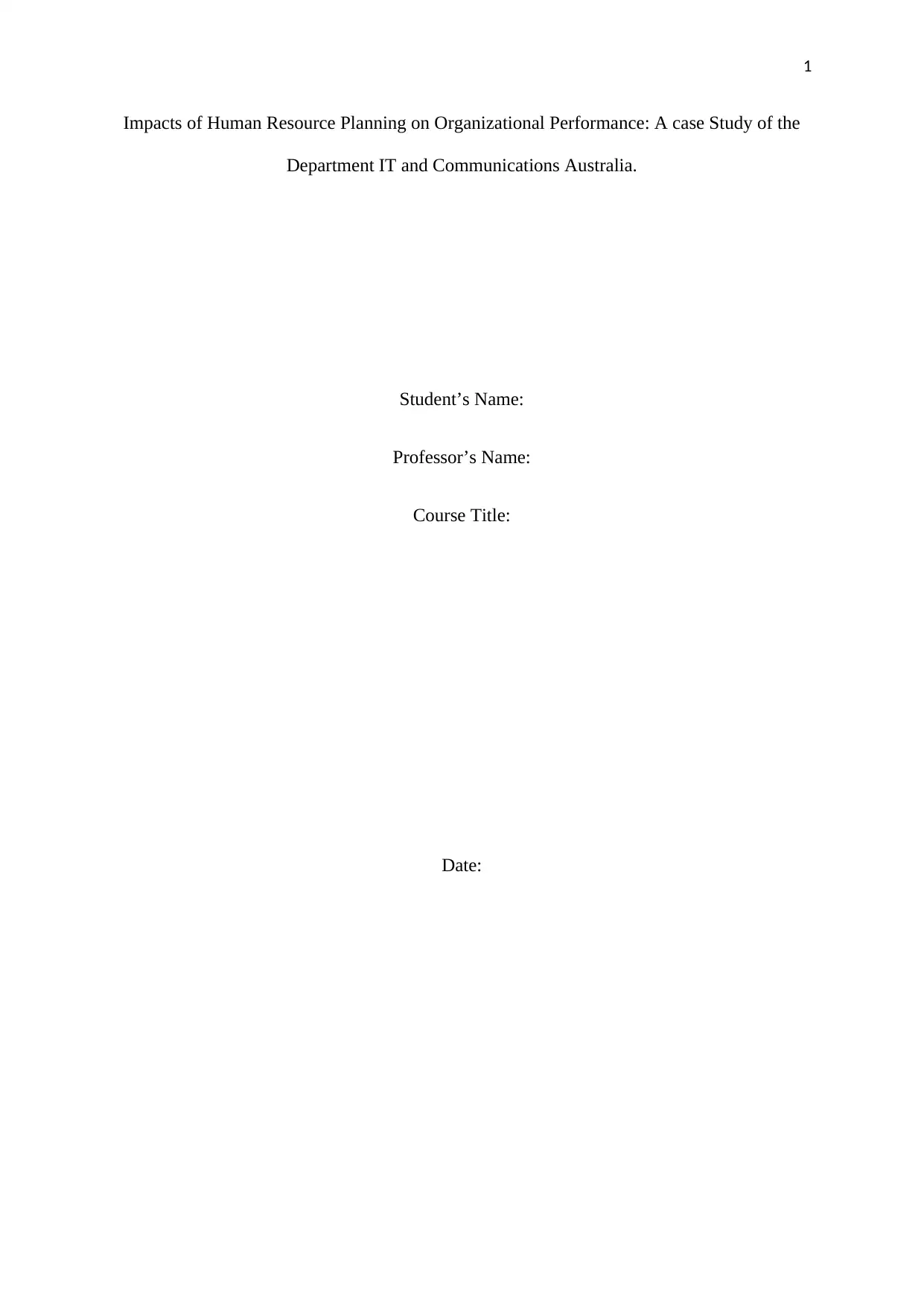
1
Impacts of Human Resource Planning on Organizational Performance: A case Study of the
Department IT and Communications Australia.
Student’s Name:
Professor’s Name:
Course Title:
Date:
Impacts of Human Resource Planning on Organizational Performance: A case Study of the
Department IT and Communications Australia.
Student’s Name:
Professor’s Name:
Course Title:
Date:
Paraphrase This Document
Need a fresh take? Get an instant paraphrase of this document with our AI Paraphraser
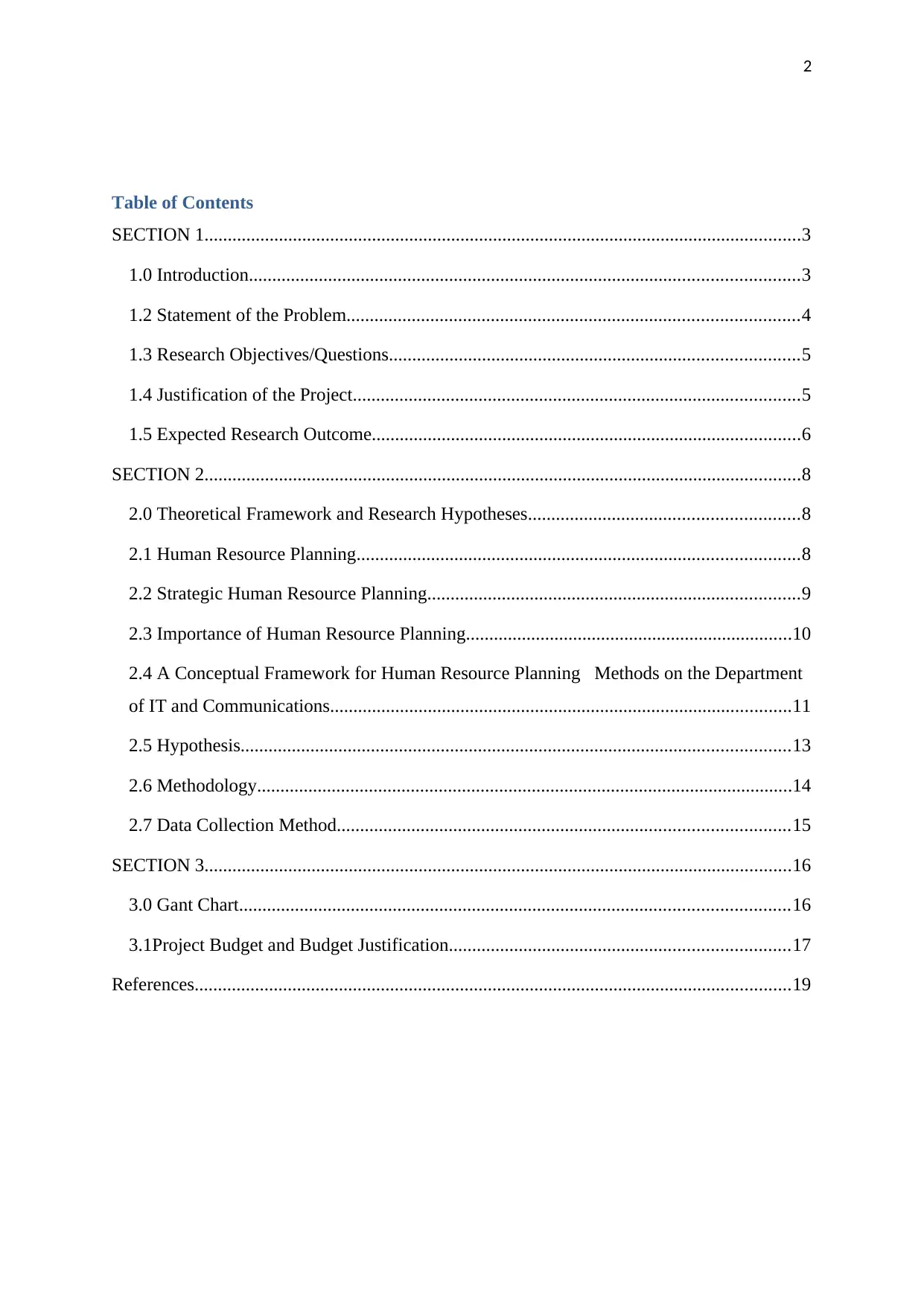
2
Table of Contents
SECTION 1................................................................................................................................3
1.0 Introduction......................................................................................................................3
1.2 Statement of the Problem.................................................................................................4
1.3 Research Objectives/Questions........................................................................................5
1.4 Justification of the Project................................................................................................5
1.5 Expected Research Outcome............................................................................................6
SECTION 2................................................................................................................................8
2.0 Theoretical Framework and Research Hypotheses..........................................................8
2.1 Human Resource Planning...............................................................................................8
2.2 Strategic Human Resource Planning................................................................................9
2.3 Importance of Human Resource Planning......................................................................10
2.4 A Conceptual Framework for Human Resource Planning Methods on the Department
of IT and Communications...................................................................................................11
2.5 Hypothesis......................................................................................................................13
2.6 Methodology...................................................................................................................14
2.7 Data Collection Method.................................................................................................15
SECTION 3..............................................................................................................................16
3.0 Gant Chart......................................................................................................................16
3.1Project Budget and Budget Justification.........................................................................17
References................................................................................................................................19
Table of Contents
SECTION 1................................................................................................................................3
1.0 Introduction......................................................................................................................3
1.2 Statement of the Problem.................................................................................................4
1.3 Research Objectives/Questions........................................................................................5
1.4 Justification of the Project................................................................................................5
1.5 Expected Research Outcome............................................................................................6
SECTION 2................................................................................................................................8
2.0 Theoretical Framework and Research Hypotheses..........................................................8
2.1 Human Resource Planning...............................................................................................8
2.2 Strategic Human Resource Planning................................................................................9
2.3 Importance of Human Resource Planning......................................................................10
2.4 A Conceptual Framework for Human Resource Planning Methods on the Department
of IT and Communications...................................................................................................11
2.5 Hypothesis......................................................................................................................13
2.6 Methodology...................................................................................................................14
2.7 Data Collection Method.................................................................................................15
SECTION 3..............................................................................................................................16
3.0 Gant Chart......................................................................................................................16
3.1Project Budget and Budget Justification.........................................................................17
References................................................................................................................................19
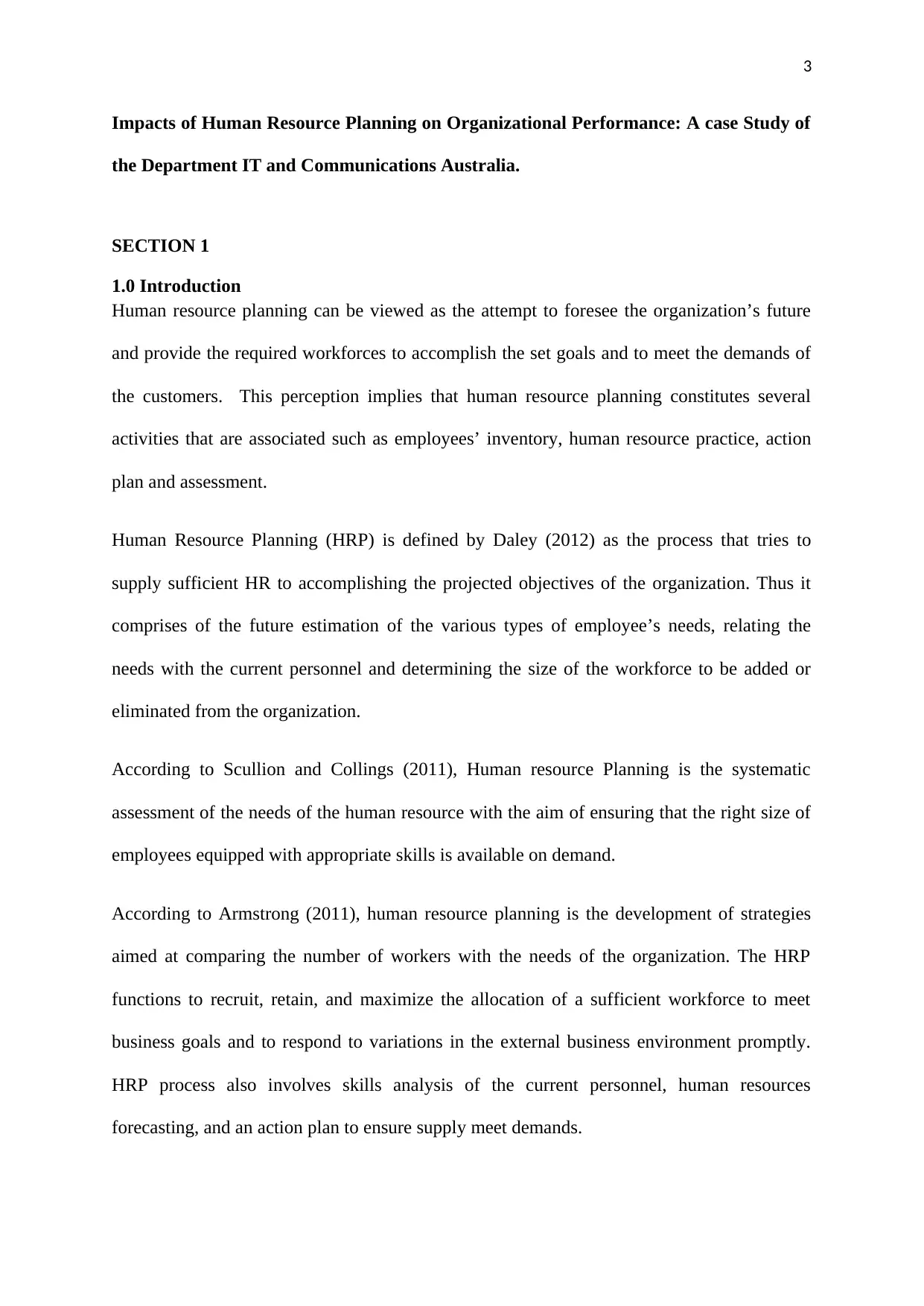
3
Impacts of Human Resource Planning on Organizational Performance: A case Study of
the Department IT and Communications Australia.
SECTION 1
1.0 Introduction
Human resource planning can be viewed as the attempt to foresee the organization’s future
and provide the required workforces to accomplish the set goals and to meet the demands of
the customers. This perception implies that human resource planning constitutes several
activities that are associated such as employees’ inventory, human resource practice, action
plan and assessment.
Human Resource Planning (HRP) is defined by Daley (2012) as the process that tries to
supply sufficient HR to accomplishing the projected objectives of the organization. Thus it
comprises of the future estimation of the various types of employee’s needs, relating the
needs with the current personnel and determining the size of the workforce to be added or
eliminated from the organization.
According to Scullion and Collings (2011), Human resource Planning is the systematic
assessment of the needs of the human resource with the aim of ensuring that the right size of
employees equipped with appropriate skills is available on demand.
According to Armstrong (2011), human resource planning is the development of strategies
aimed at comparing the number of workers with the needs of the organization. The HRP
functions to recruit, retain, and maximize the allocation of a sufficient workforce to meet
business goals and to respond to variations in the external business environment promptly.
HRP process also involves skills analysis of the current personnel, human resources
forecasting, and an action plan to ensure supply meet demands.
Impacts of Human Resource Planning on Organizational Performance: A case Study of
the Department IT and Communications Australia.
SECTION 1
1.0 Introduction
Human resource planning can be viewed as the attempt to foresee the organization’s future
and provide the required workforces to accomplish the set goals and to meet the demands of
the customers. This perception implies that human resource planning constitutes several
activities that are associated such as employees’ inventory, human resource practice, action
plan and assessment.
Human Resource Planning (HRP) is defined by Daley (2012) as the process that tries to
supply sufficient HR to accomplishing the projected objectives of the organization. Thus it
comprises of the future estimation of the various types of employee’s needs, relating the
needs with the current personnel and determining the size of the workforce to be added or
eliminated from the organization.
According to Scullion and Collings (2011), Human resource Planning is the systematic
assessment of the needs of the human resource with the aim of ensuring that the right size of
employees equipped with appropriate skills is available on demand.
According to Armstrong (2011), human resource planning is the development of strategies
aimed at comparing the number of workers with the needs of the organization. The HRP
functions to recruit, retain, and maximize the allocation of a sufficient workforce to meet
business goals and to respond to variations in the external business environment promptly.
HRP process also involves skills analysis of the current personnel, human resources
forecasting, and an action plan to ensure supply meet demands.
⊘ This is a preview!⊘
Do you want full access?
Subscribe today to unlock all pages.

Trusted by 1+ million students worldwide
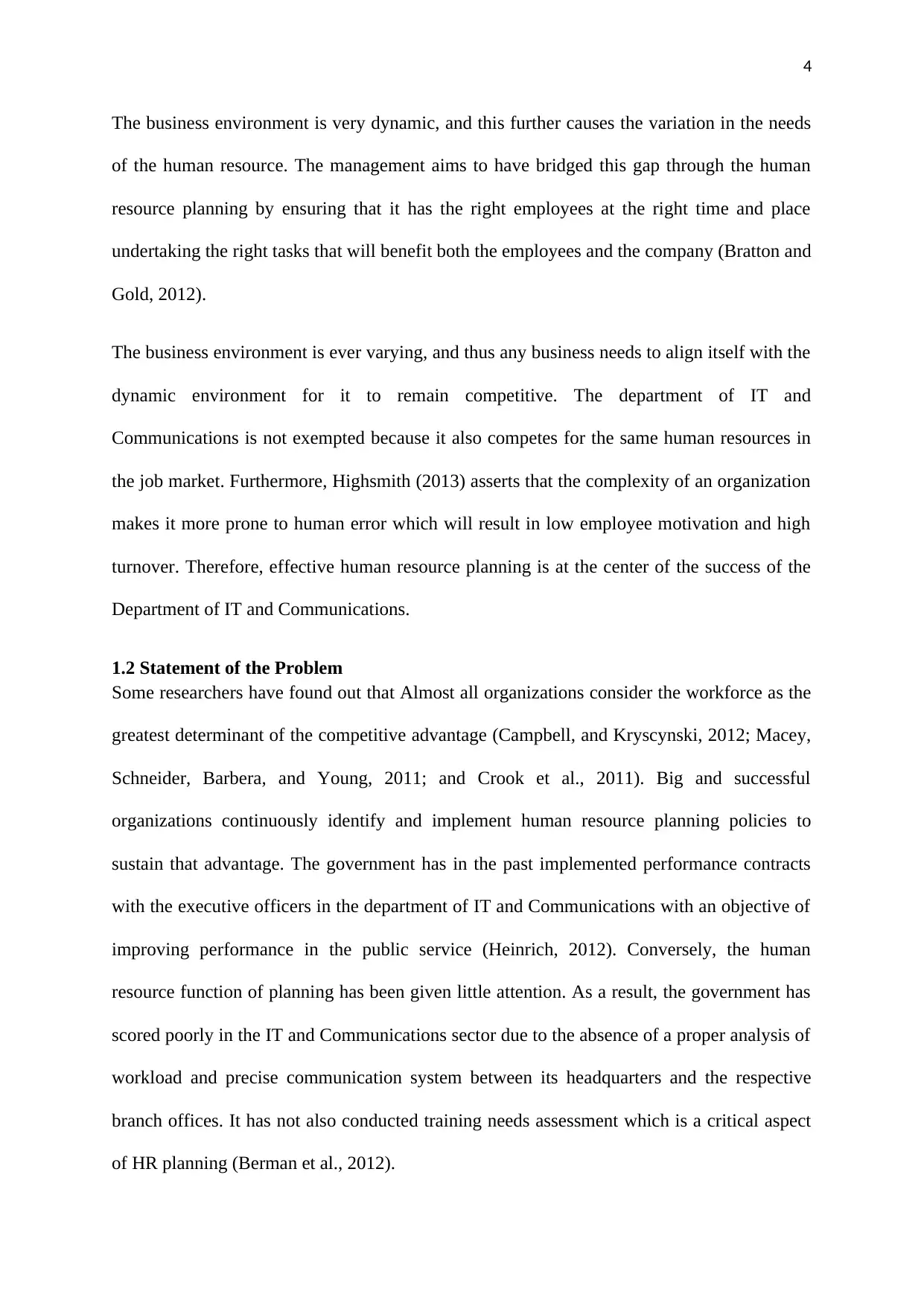
4
The business environment is very dynamic, and this further causes the variation in the needs
of the human resource. The management aims to have bridged this gap through the human
resource planning by ensuring that it has the right employees at the right time and place
undertaking the right tasks that will benefit both the employees and the company (Bratton and
Gold, 2012).
The business environment is ever varying, and thus any business needs to align itself with the
dynamic environment for it to remain competitive. The department of IT and
Communications is not exempted because it also competes for the same human resources in
the job market. Furthermore, Highsmith (2013) asserts that the complexity of an organization
makes it more prone to human error which will result in low employee motivation and high
turnover. Therefore, effective human resource planning is at the center of the success of the
Department of IT and Communications.
1.2 Statement of the Problem
Some researchers have found out that Almost all organizations consider the workforce as the
greatest determinant of the competitive advantage (Campbell, and Kryscynski, 2012; Macey,
Schneider, Barbera, and Young, 2011; and Crook et al., 2011). Big and successful
organizations continuously identify and implement human resource planning policies to
sustain that advantage. The government has in the past implemented performance contracts
with the executive officers in the department of IT and Communications with an objective of
improving performance in the public service (Heinrich, 2012). Conversely, the human
resource function of planning has been given little attention. As a result, the government has
scored poorly in the IT and Communications sector due to the absence of a proper analysis of
workload and precise communication system between its headquarters and the respective
branch offices. It has not also conducted training needs assessment which is a critical aspect
of HR planning (Berman et al., 2012).
The business environment is very dynamic, and this further causes the variation in the needs
of the human resource. The management aims to have bridged this gap through the human
resource planning by ensuring that it has the right employees at the right time and place
undertaking the right tasks that will benefit both the employees and the company (Bratton and
Gold, 2012).
The business environment is ever varying, and thus any business needs to align itself with the
dynamic environment for it to remain competitive. The department of IT and
Communications is not exempted because it also competes for the same human resources in
the job market. Furthermore, Highsmith (2013) asserts that the complexity of an organization
makes it more prone to human error which will result in low employee motivation and high
turnover. Therefore, effective human resource planning is at the center of the success of the
Department of IT and Communications.
1.2 Statement of the Problem
Some researchers have found out that Almost all organizations consider the workforce as the
greatest determinant of the competitive advantage (Campbell, and Kryscynski, 2012; Macey,
Schneider, Barbera, and Young, 2011; and Crook et al., 2011). Big and successful
organizations continuously identify and implement human resource planning policies to
sustain that advantage. The government has in the past implemented performance contracts
with the executive officers in the department of IT and Communications with an objective of
improving performance in the public service (Heinrich, 2012). Conversely, the human
resource function of planning has been given little attention. As a result, the government has
scored poorly in the IT and Communications sector due to the absence of a proper analysis of
workload and precise communication system between its headquarters and the respective
branch offices. It has not also conducted training needs assessment which is a critical aspect
of HR planning (Berman et al., 2012).
Paraphrase This Document
Need a fresh take? Get an instant paraphrase of this document with our AI Paraphraser
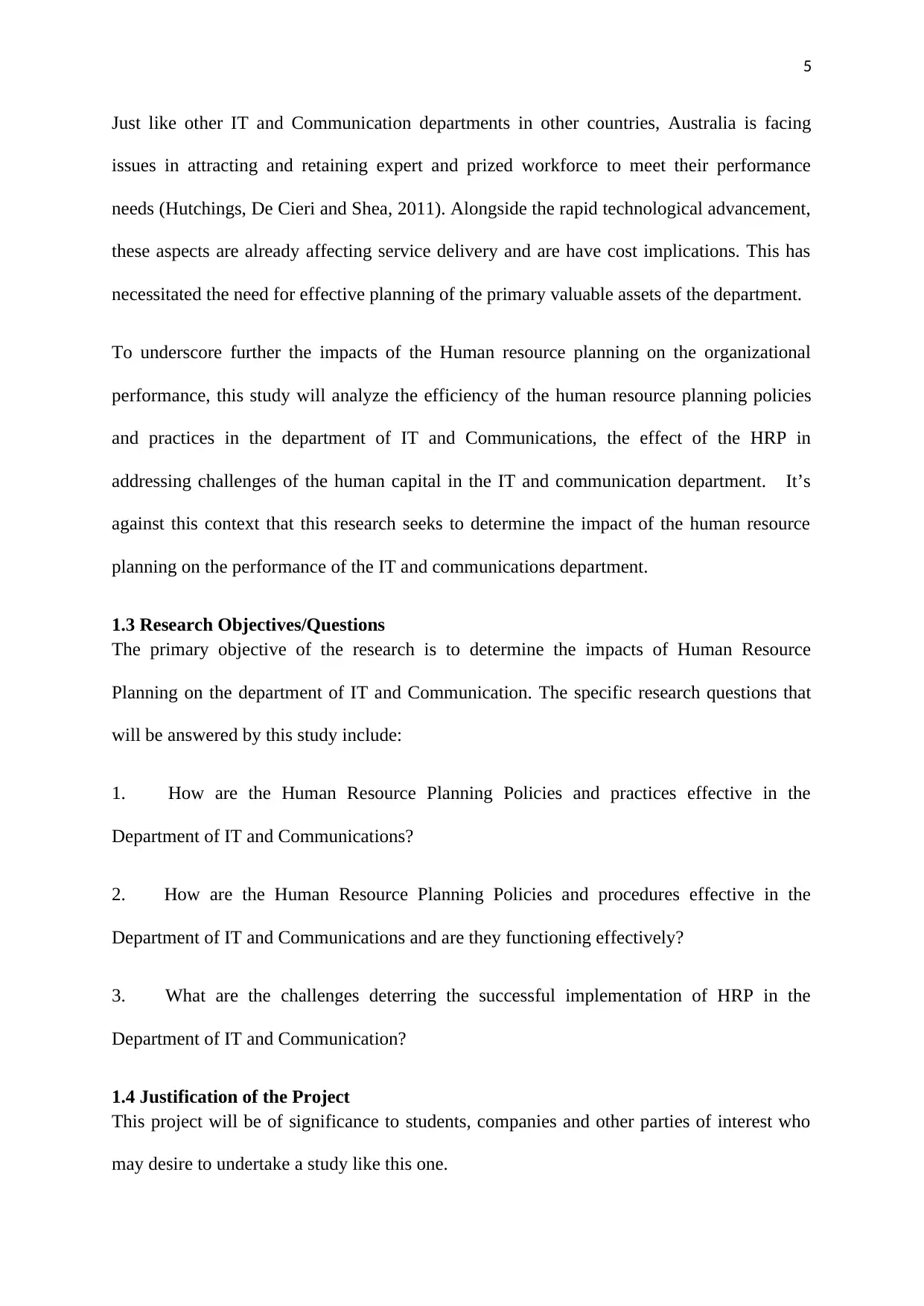
5
Just like other IT and Communication departments in other countries, Australia is facing
issues in attracting and retaining expert and prized workforce to meet their performance
needs (Hutchings, De Cieri and Shea, 2011). Alongside the rapid technological advancement,
these aspects are already affecting service delivery and are have cost implications. This has
necessitated the need for effective planning of the primary valuable assets of the department.
To underscore further the impacts of the Human resource planning on the organizational
performance, this study will analyze the efficiency of the human resource planning policies
and practices in the department of IT and Communications, the effect of the HRP in
addressing challenges of the human capital in the IT and communication department. It’s
against this context that this research seeks to determine the impact of the human resource
planning on the performance of the IT and communications department.
1.3 Research Objectives/Questions
The primary objective of the research is to determine the impacts of Human Resource
Planning on the department of IT and Communication. The specific research questions that
will be answered by this study include:
1. How are the Human Resource Planning Policies and practices effective in the
Department of IT and Communications?
2. How are the Human Resource Planning Policies and procedures effective in the
Department of IT and Communications and are they functioning effectively?
3. What are the challenges deterring the successful implementation of HRP in the
Department of IT and Communication?
1.4 Justification of the Project
This project will be of significance to students, companies and other parties of interest who
may desire to undertake a study like this one.
Just like other IT and Communication departments in other countries, Australia is facing
issues in attracting and retaining expert and prized workforce to meet their performance
needs (Hutchings, De Cieri and Shea, 2011). Alongside the rapid technological advancement,
these aspects are already affecting service delivery and are have cost implications. This has
necessitated the need for effective planning of the primary valuable assets of the department.
To underscore further the impacts of the Human resource planning on the organizational
performance, this study will analyze the efficiency of the human resource planning policies
and practices in the department of IT and Communications, the effect of the HRP in
addressing challenges of the human capital in the IT and communication department. It’s
against this context that this research seeks to determine the impact of the human resource
planning on the performance of the IT and communications department.
1.3 Research Objectives/Questions
The primary objective of the research is to determine the impacts of Human Resource
Planning on the department of IT and Communication. The specific research questions that
will be answered by this study include:
1. How are the Human Resource Planning Policies and practices effective in the
Department of IT and Communications?
2. How are the Human Resource Planning Policies and procedures effective in the
Department of IT and Communications and are they functioning effectively?
3. What are the challenges deterring the successful implementation of HRP in the
Department of IT and Communication?
1.4 Justification of the Project
This project will be of significance to students, companies and other parties of interest who
may desire to undertake a study like this one.
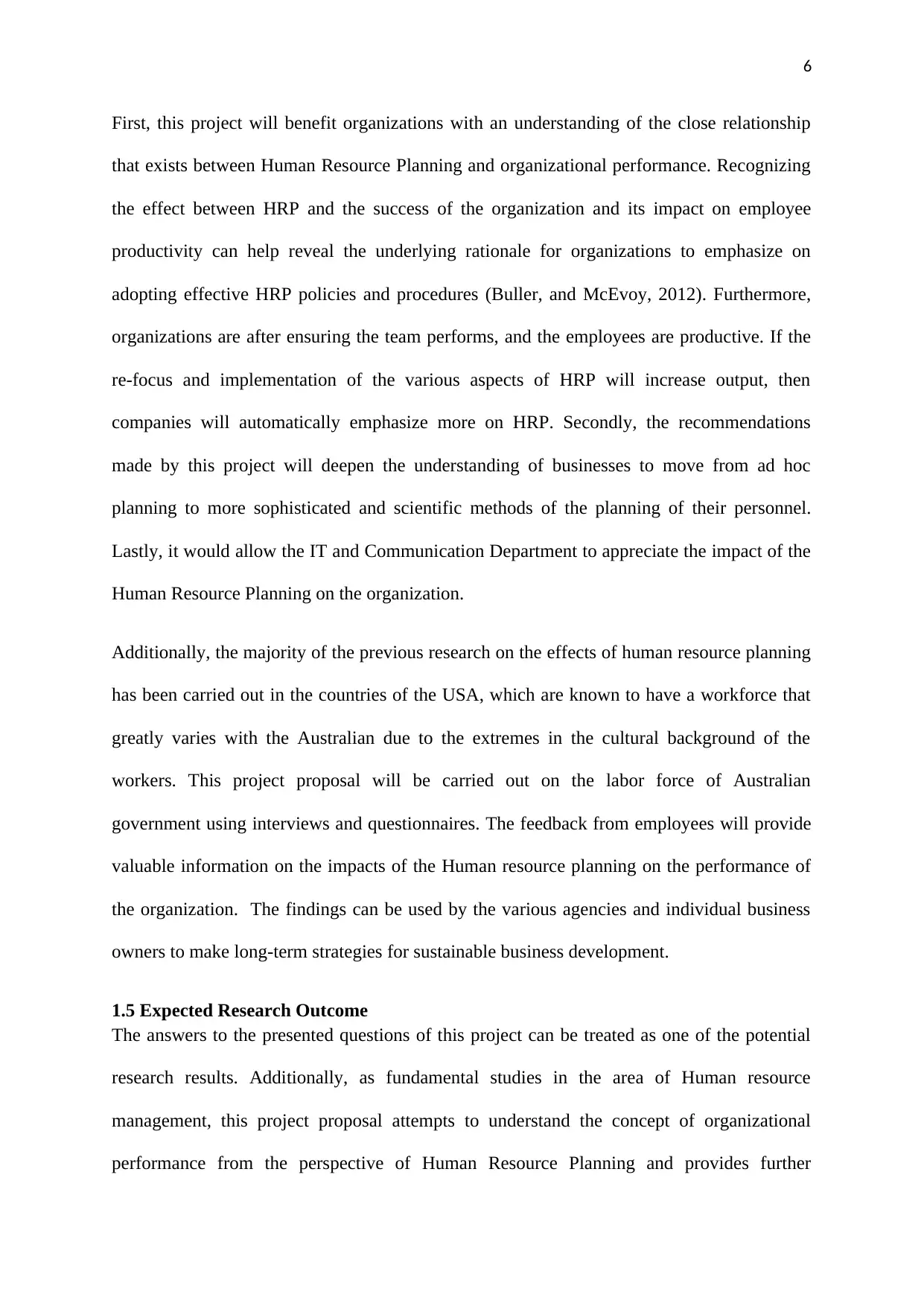
6
First, this project will benefit organizations with an understanding of the close relationship
that exists between Human Resource Planning and organizational performance. Recognizing
the effect between HRP and the success of the organization and its impact on employee
productivity can help reveal the underlying rationale for organizations to emphasize on
adopting effective HRP policies and procedures (Buller, and McEvoy, 2012). Furthermore,
organizations are after ensuring the team performs, and the employees are productive. If the
re-focus and implementation of the various aspects of HRP will increase output, then
companies will automatically emphasize more on HRP. Secondly, the recommendations
made by this project will deepen the understanding of businesses to move from ad hoc
planning to more sophisticated and scientific methods of the planning of their personnel.
Lastly, it would allow the IT and Communication Department to appreciate the impact of the
Human Resource Planning on the organization.
Additionally, the majority of the previous research on the effects of human resource planning
has been carried out in the countries of the USA, which are known to have a workforce that
greatly varies with the Australian due to the extremes in the cultural background of the
workers. This project proposal will be carried out on the labor force of Australian
government using interviews and questionnaires. The feedback from employees will provide
valuable information on the impacts of the Human resource planning on the performance of
the organization. The findings can be used by the various agencies and individual business
owners to make long-term strategies for sustainable business development.
1.5 Expected Research Outcome
The answers to the presented questions of this project can be treated as one of the potential
research results. Additionally, as fundamental studies in the area of Human resource
management, this project proposal attempts to understand the concept of organizational
performance from the perspective of Human Resource Planning and provides further
First, this project will benefit organizations with an understanding of the close relationship
that exists between Human Resource Planning and organizational performance. Recognizing
the effect between HRP and the success of the organization and its impact on employee
productivity can help reveal the underlying rationale for organizations to emphasize on
adopting effective HRP policies and procedures (Buller, and McEvoy, 2012). Furthermore,
organizations are after ensuring the team performs, and the employees are productive. If the
re-focus and implementation of the various aspects of HRP will increase output, then
companies will automatically emphasize more on HRP. Secondly, the recommendations
made by this project will deepen the understanding of businesses to move from ad hoc
planning to more sophisticated and scientific methods of the planning of their personnel.
Lastly, it would allow the IT and Communication Department to appreciate the impact of the
Human Resource Planning on the organization.
Additionally, the majority of the previous research on the effects of human resource planning
has been carried out in the countries of the USA, which are known to have a workforce that
greatly varies with the Australian due to the extremes in the cultural background of the
workers. This project proposal will be carried out on the labor force of Australian
government using interviews and questionnaires. The feedback from employees will provide
valuable information on the impacts of the Human resource planning on the performance of
the organization. The findings can be used by the various agencies and individual business
owners to make long-term strategies for sustainable business development.
1.5 Expected Research Outcome
The answers to the presented questions of this project can be treated as one of the potential
research results. Additionally, as fundamental studies in the area of Human resource
management, this project proposal attempts to understand the concept of organizational
performance from the perspective of Human Resource Planning and provides further
⊘ This is a preview!⊘
Do you want full access?
Subscribe today to unlock all pages.

Trusted by 1+ million students worldwide
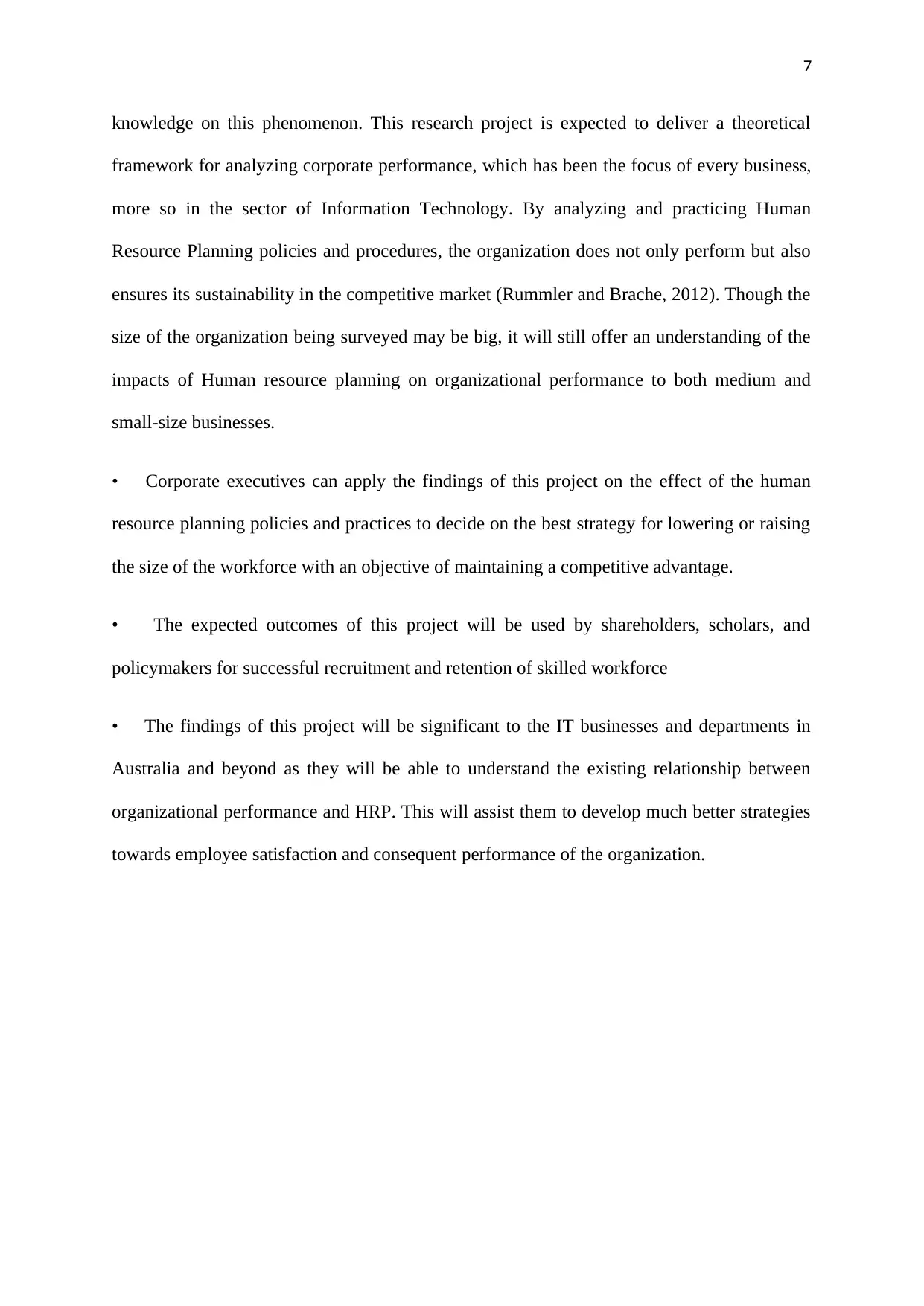
7
knowledge on this phenomenon. This research project is expected to deliver a theoretical
framework for analyzing corporate performance, which has been the focus of every business,
more so in the sector of Information Technology. By analyzing and practicing Human
Resource Planning policies and procedures, the organization does not only perform but also
ensures its sustainability in the competitive market (Rummler and Brache, 2012). Though the
size of the organization being surveyed may be big, it will still offer an understanding of the
impacts of Human resource planning on organizational performance to both medium and
small-size businesses.
• Corporate executives can apply the findings of this project on the effect of the human
resource planning policies and practices to decide on the best strategy for lowering or raising
the size of the workforce with an objective of maintaining a competitive advantage.
• The expected outcomes of this project will be used by shareholders, scholars, and
policymakers for successful recruitment and retention of skilled workforce
• The findings of this project will be significant to the IT businesses and departments in
Australia and beyond as they will be able to understand the existing relationship between
organizational performance and HRP. This will assist them to develop much better strategies
towards employee satisfaction and consequent performance of the organization.
knowledge on this phenomenon. This research project is expected to deliver a theoretical
framework for analyzing corporate performance, which has been the focus of every business,
more so in the sector of Information Technology. By analyzing and practicing Human
Resource Planning policies and procedures, the organization does not only perform but also
ensures its sustainability in the competitive market (Rummler and Brache, 2012). Though the
size of the organization being surveyed may be big, it will still offer an understanding of the
impacts of Human resource planning on organizational performance to both medium and
small-size businesses.
• Corporate executives can apply the findings of this project on the effect of the human
resource planning policies and practices to decide on the best strategy for lowering or raising
the size of the workforce with an objective of maintaining a competitive advantage.
• The expected outcomes of this project will be used by shareholders, scholars, and
policymakers for successful recruitment and retention of skilled workforce
• The findings of this project will be significant to the IT businesses and departments in
Australia and beyond as they will be able to understand the existing relationship between
organizational performance and HRP. This will assist them to develop much better strategies
towards employee satisfaction and consequent performance of the organization.
Paraphrase This Document
Need a fresh take? Get an instant paraphrase of this document with our AI Paraphraser
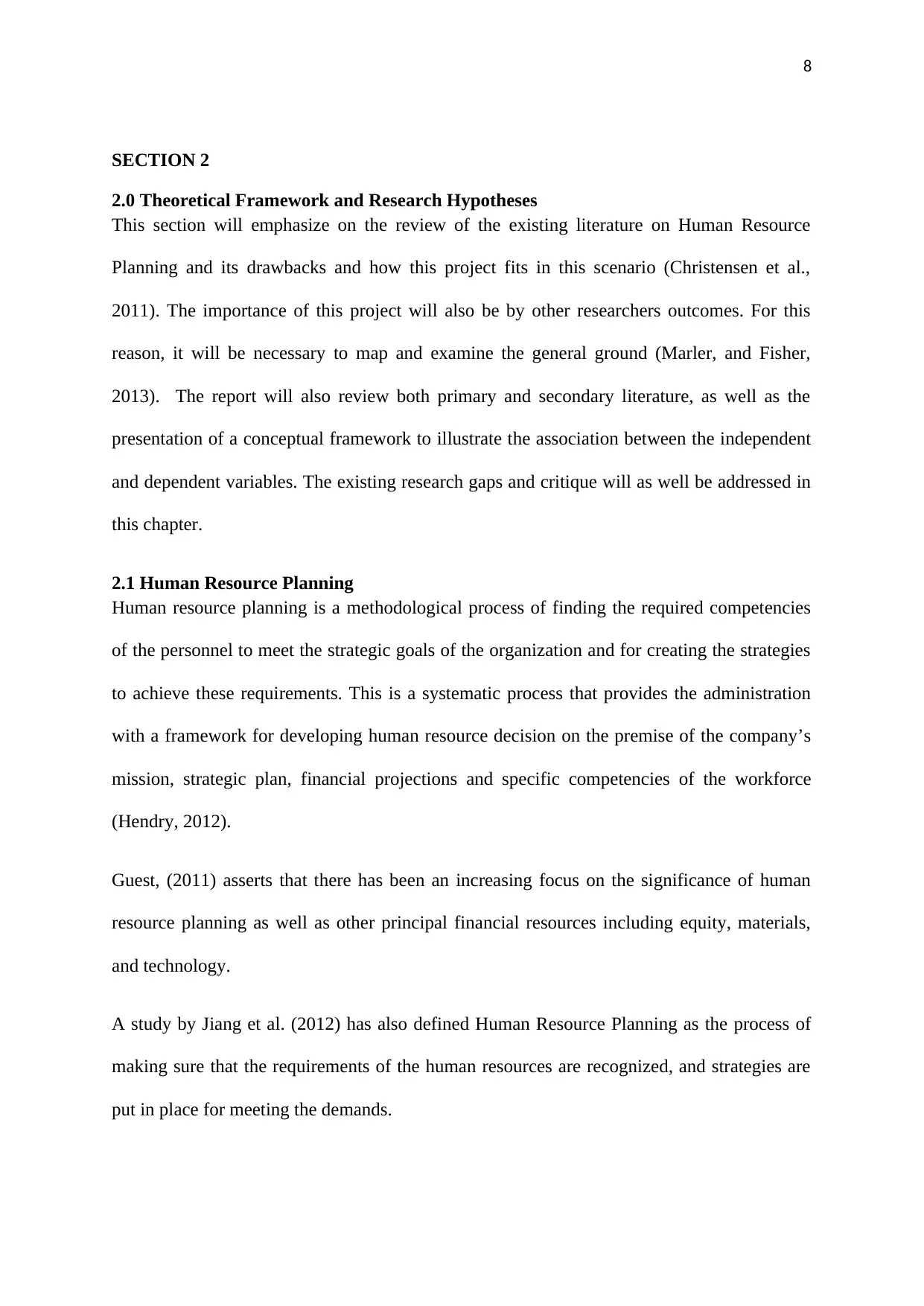
8
SECTION 2
2.0 Theoretical Framework and Research Hypotheses
This section will emphasize on the review of the existing literature on Human Resource
Planning and its drawbacks and how this project fits in this scenario (Christensen et al.,
2011). The importance of this project will also be by other researchers outcomes. For this
reason, it will be necessary to map and examine the general ground (Marler, and Fisher,
2013). The report will also review both primary and secondary literature, as well as the
presentation of a conceptual framework to illustrate the association between the independent
and dependent variables. The existing research gaps and critique will as well be addressed in
this chapter.
2.1 Human Resource Planning
Human resource planning is a methodological process of finding the required competencies
of the personnel to meet the strategic goals of the organization and for creating the strategies
to achieve these requirements. This is a systematic process that provides the administration
with a framework for developing human resource decision on the premise of the company’s
mission, strategic plan, financial projections and specific competencies of the workforce
(Hendry, 2012).
Guest, (2011) asserts that there has been an increasing focus on the significance of human
resource planning as well as other principal financial resources including equity, materials,
and technology.
A study by Jiang et al. (2012) has also defined Human Resource Planning as the process of
making sure that the requirements of the human resources are recognized, and strategies are
put in place for meeting the demands.
SECTION 2
2.0 Theoretical Framework and Research Hypotheses
This section will emphasize on the review of the existing literature on Human Resource
Planning and its drawbacks and how this project fits in this scenario (Christensen et al.,
2011). The importance of this project will also be by other researchers outcomes. For this
reason, it will be necessary to map and examine the general ground (Marler, and Fisher,
2013). The report will also review both primary and secondary literature, as well as the
presentation of a conceptual framework to illustrate the association between the independent
and dependent variables. The existing research gaps and critique will as well be addressed in
this chapter.
2.1 Human Resource Planning
Human resource planning is a methodological process of finding the required competencies
of the personnel to meet the strategic goals of the organization and for creating the strategies
to achieve these requirements. This is a systematic process that provides the administration
with a framework for developing human resource decision on the premise of the company’s
mission, strategic plan, financial projections and specific competencies of the workforce
(Hendry, 2012).
Guest, (2011) asserts that there has been an increasing focus on the significance of human
resource planning as well as other principal financial resources including equity, materials,
and technology.
A study by Jiang et al. (2012) has also defined Human Resource Planning as the process of
making sure that the requirements of the human resources are recognized, and strategies are
put in place for meeting the demands.
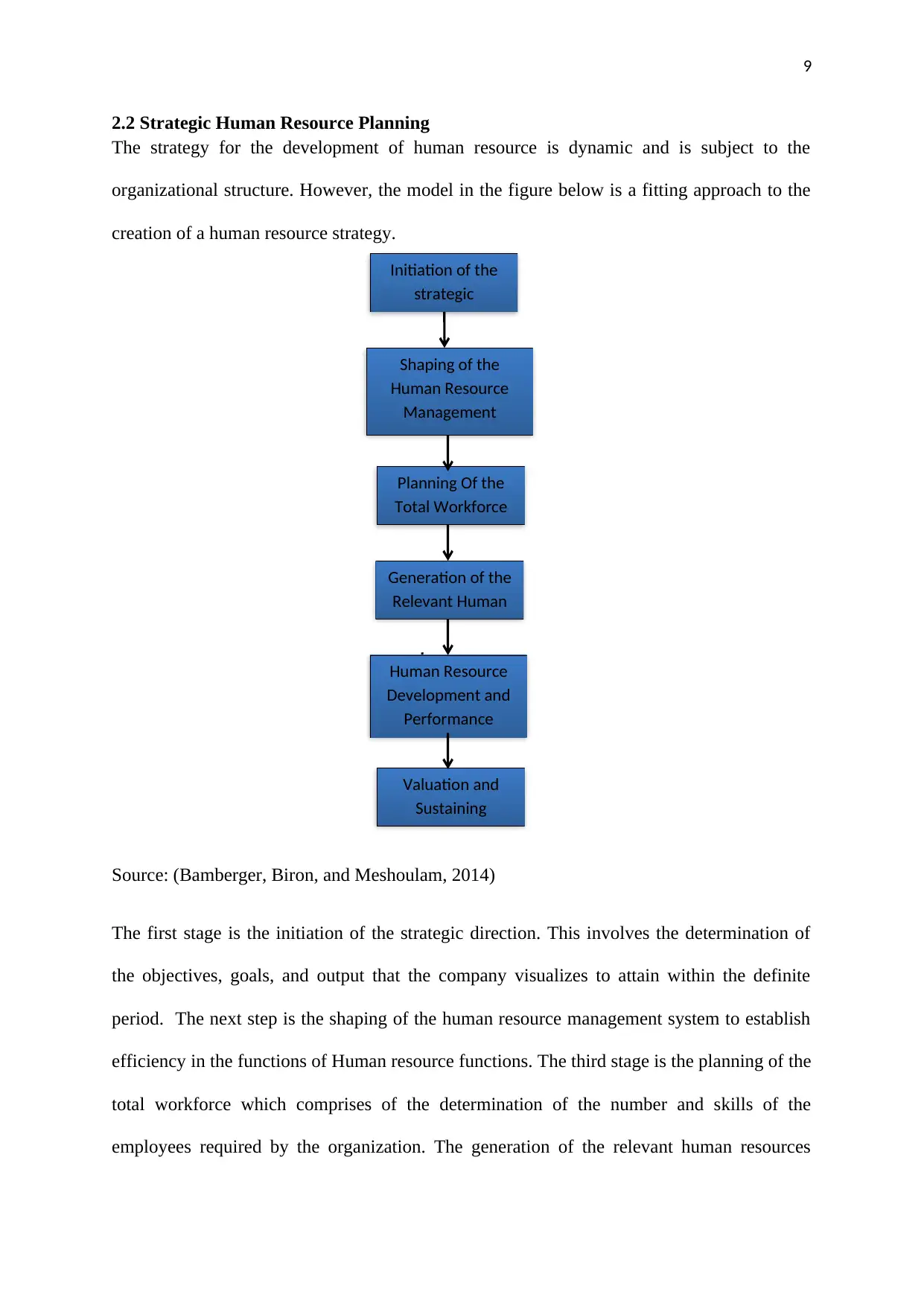
9
2.2 Strategic Human Resource Planning
The strategy for the development of human resource is dynamic and is subject to the
organizational structure. However, the model in the figure below is a fitting approach to the
creation of a human resource strategy.
Source: (Bamberger, Biron, and Meshoulam, 2014)
The first stage is the initiation of the strategic direction. This involves the determination of
the objectives, goals, and output that the company visualizes to attain within the definite
period. The next step is the shaping of the human resource management system to establish
efficiency in the functions of Human resource functions. The third stage is the planning of the
total workforce which comprises of the determination of the number and skills of the
employees required by the organization. The generation of the relevant human resources
Planning Of the
Total Workforce
Direction
Generation of the
Relevant Human
Resources
Valuation and
Sustaining
Structural
Human Resource
Development and
Performance
Direction
Shaping of the
Human Resource
Management
system direction
Initiation of the
strategic
direction
2.2 Strategic Human Resource Planning
The strategy for the development of human resource is dynamic and is subject to the
organizational structure. However, the model in the figure below is a fitting approach to the
creation of a human resource strategy.
Source: (Bamberger, Biron, and Meshoulam, 2014)
The first stage is the initiation of the strategic direction. This involves the determination of
the objectives, goals, and output that the company visualizes to attain within the definite
period. The next step is the shaping of the human resource management system to establish
efficiency in the functions of Human resource functions. The third stage is the planning of the
total workforce which comprises of the determination of the number and skills of the
employees required by the organization. The generation of the relevant human resources
Planning Of the
Total Workforce
Direction
Generation of the
Relevant Human
Resources
Valuation and
Sustaining
Structural
Human Resource
Development and
Performance
Direction
Shaping of the
Human Resource
Management
system direction
Initiation of the
strategic
direction
⊘ This is a preview!⊘
Do you want full access?
Subscribe today to unlock all pages.

Trusted by 1+ million students worldwide
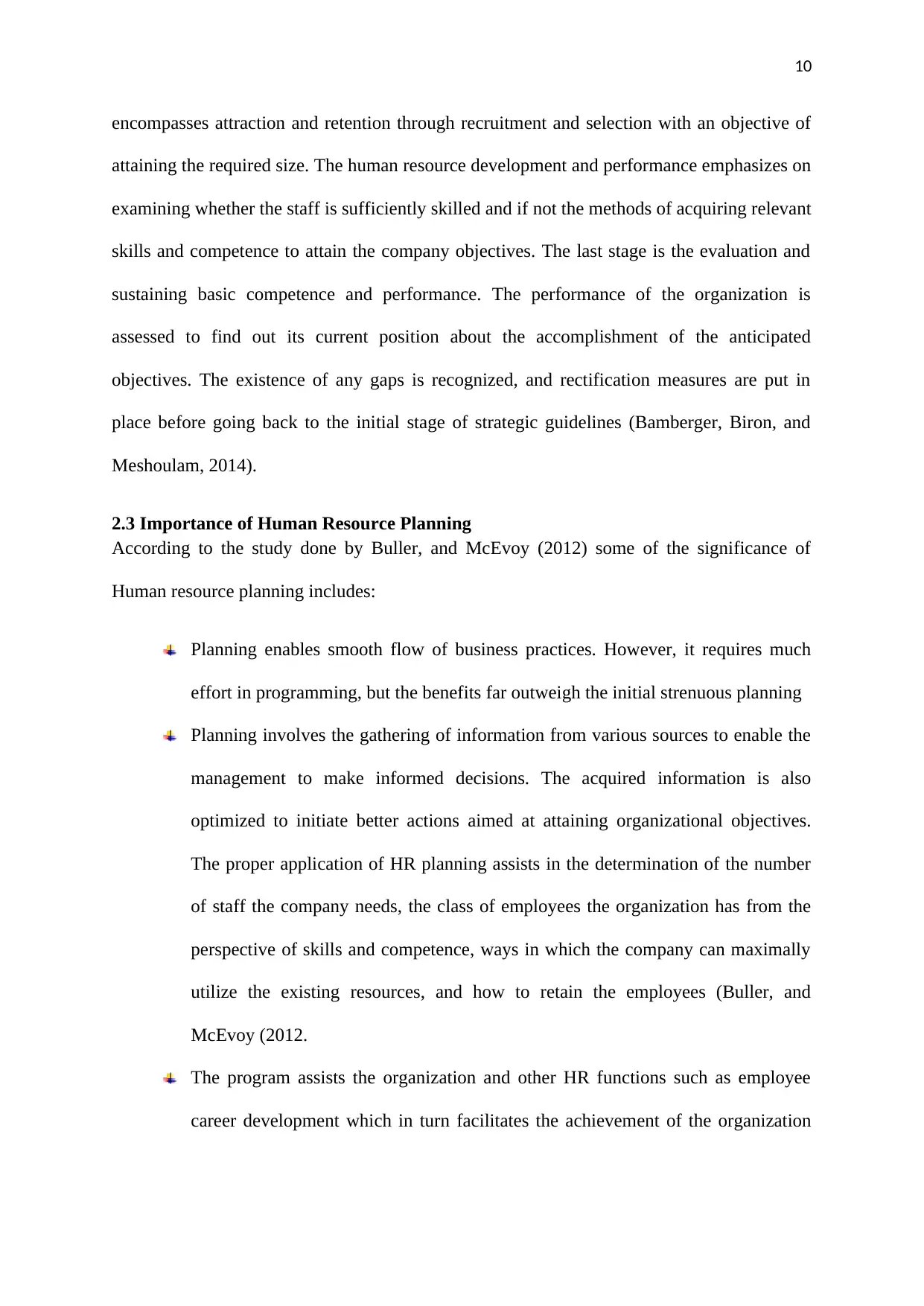
10
encompasses attraction and retention through recruitment and selection with an objective of
attaining the required size. The human resource development and performance emphasizes on
examining whether the staff is sufficiently skilled and if not the methods of acquiring relevant
skills and competence to attain the company objectives. The last stage is the evaluation and
sustaining basic competence and performance. The performance of the organization is
assessed to find out its current position about the accomplishment of the anticipated
objectives. The existence of any gaps is recognized, and rectification measures are put in
place before going back to the initial stage of strategic guidelines (Bamberger, Biron, and
Meshoulam, 2014).
2.3 Importance of Human Resource Planning
According to the study done by Buller, and McEvoy (2012) some of the significance of
Human resource planning includes:
Planning enables smooth flow of business practices. However, it requires much
effort in programming, but the benefits far outweigh the initial strenuous planning
Planning involves the gathering of information from various sources to enable the
management to make informed decisions. The acquired information is also
optimized to initiate better actions aimed at attaining organizational objectives.
The proper application of HR planning assists in the determination of the number
of staff the company needs, the class of employees the organization has from the
perspective of skills and competence, ways in which the company can maximally
utilize the existing resources, and how to retain the employees (Buller, and
McEvoy (2012.
The program assists the organization and other HR functions such as employee
career development which in turn facilitates the achievement of the organization
encompasses attraction and retention through recruitment and selection with an objective of
attaining the required size. The human resource development and performance emphasizes on
examining whether the staff is sufficiently skilled and if not the methods of acquiring relevant
skills and competence to attain the company objectives. The last stage is the evaluation and
sustaining basic competence and performance. The performance of the organization is
assessed to find out its current position about the accomplishment of the anticipated
objectives. The existence of any gaps is recognized, and rectification measures are put in
place before going back to the initial stage of strategic guidelines (Bamberger, Biron, and
Meshoulam, 2014).
2.3 Importance of Human Resource Planning
According to the study done by Buller, and McEvoy (2012) some of the significance of
Human resource planning includes:
Planning enables smooth flow of business practices. However, it requires much
effort in programming, but the benefits far outweigh the initial strenuous planning
Planning involves the gathering of information from various sources to enable the
management to make informed decisions. The acquired information is also
optimized to initiate better actions aimed at attaining organizational objectives.
The proper application of HR planning assists in the determination of the number
of staff the company needs, the class of employees the organization has from the
perspective of skills and competence, ways in which the company can maximally
utilize the existing resources, and how to retain the employees (Buller, and
McEvoy (2012.
The program assists the organization and other HR functions such as employee
career development which in turn facilitates the achievement of the organization
Paraphrase This Document
Need a fresh take? Get an instant paraphrase of this document with our AI Paraphraser
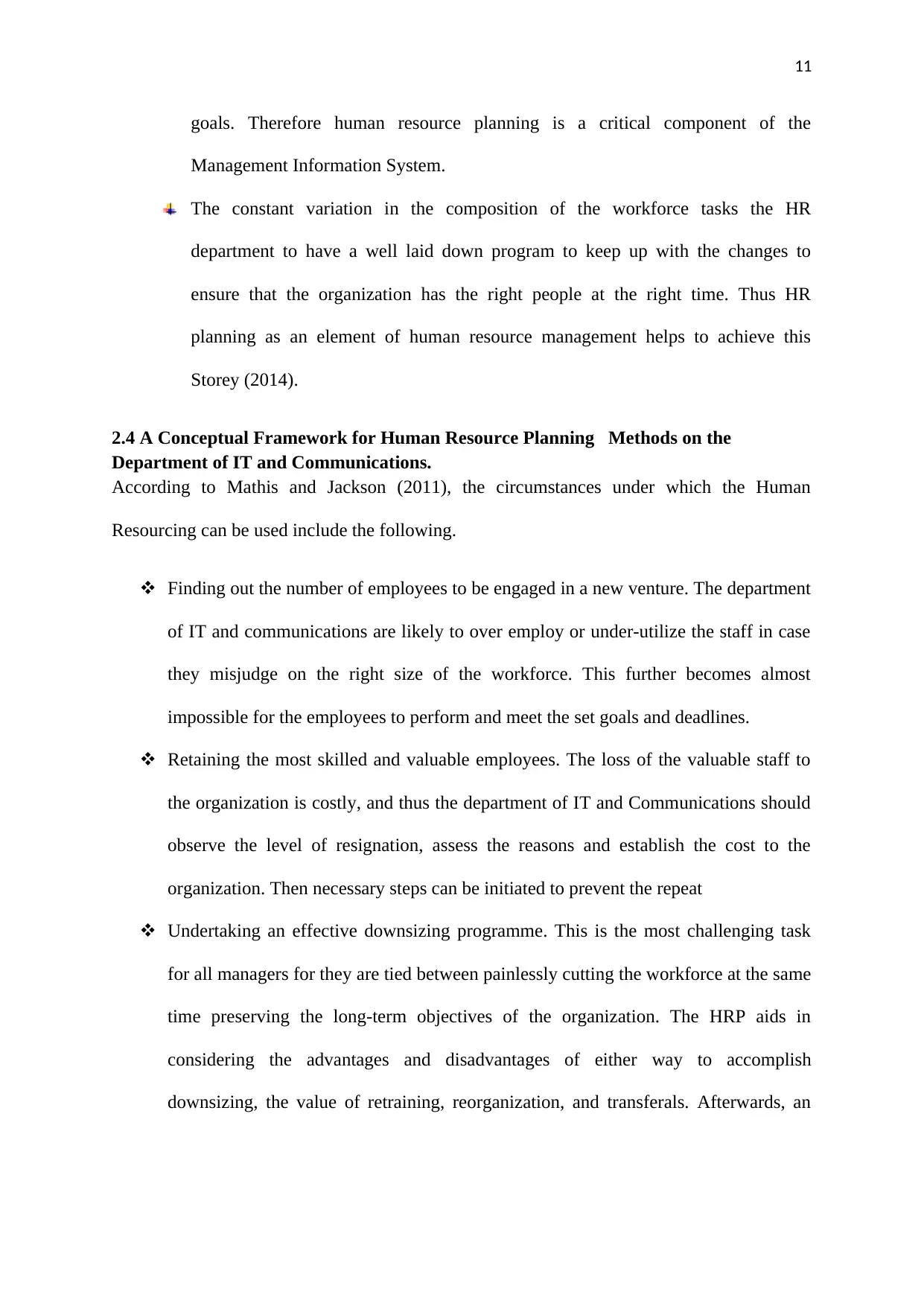
11
goals. Therefore human resource planning is a critical component of the
Management Information System.
The constant variation in the composition of the workforce tasks the HR
department to have a well laid down program to keep up with the changes to
ensure that the organization has the right people at the right time. Thus HR
planning as an element of human resource management helps to achieve this
Storey (2014).
2.4 A Conceptual Framework for Human Resource Planning Methods on the
Department of IT and Communications.
According to Mathis and Jackson (2011), the circumstances under which the Human
Resourcing can be used include the following.
Finding out the number of employees to be engaged in a new venture. The department
of IT and communications are likely to over employ or under-utilize the staff in case
they misjudge on the right size of the workforce. This further becomes almost
impossible for the employees to perform and meet the set goals and deadlines.
Retaining the most skilled and valuable employees. The loss of the valuable staff to
the organization is costly, and thus the department of IT and Communications should
observe the level of resignation, assess the reasons and establish the cost to the
organization. Then necessary steps can be initiated to prevent the repeat
Undertaking an effective downsizing programme. This is the most challenging task
for all managers for they are tied between painlessly cutting the workforce at the same
time preserving the long-term objectives of the organization. The HRP aids in
considering the advantages and disadvantages of either way to accomplish
downsizing, the value of retraining, reorganization, and transferals. Afterwards, an
goals. Therefore human resource planning is a critical component of the
Management Information System.
The constant variation in the composition of the workforce tasks the HR
department to have a well laid down program to keep up with the changes to
ensure that the organization has the right people at the right time. Thus HR
planning as an element of human resource management helps to achieve this
Storey (2014).
2.4 A Conceptual Framework for Human Resource Planning Methods on the
Department of IT and Communications.
According to Mathis and Jackson (2011), the circumstances under which the Human
Resourcing can be used include the following.
Finding out the number of employees to be engaged in a new venture. The department
of IT and communications are likely to over employ or under-utilize the staff in case
they misjudge on the right size of the workforce. This further becomes almost
impossible for the employees to perform and meet the set goals and deadlines.
Retaining the most skilled and valuable employees. The loss of the valuable staff to
the organization is costly, and thus the department of IT and Communications should
observe the level of resignation, assess the reasons and establish the cost to the
organization. Then necessary steps can be initiated to prevent the repeat
Undertaking an effective downsizing programme. This is the most challenging task
for all managers for they are tied between painlessly cutting the workforce at the same
time preserving the long-term objectives of the organization. The HRP aids in
considering the advantages and disadvantages of either way to accomplish
downsizing, the value of retraining, reorganization, and transferals. Afterwards, an
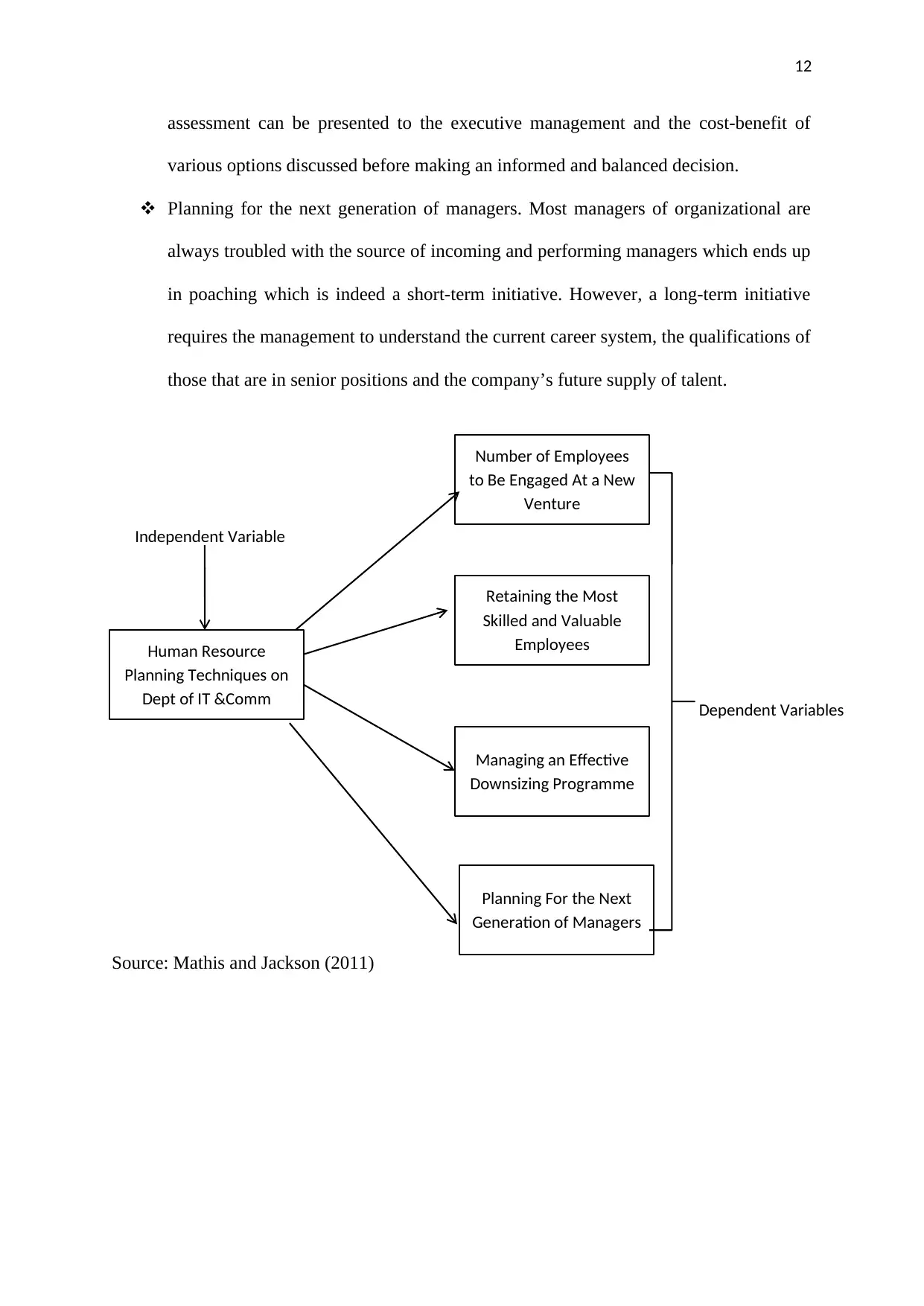
12
assessment can be presented to the executive management and the cost-benefit of
various options discussed before making an informed and balanced decision.
Planning for the next generation of managers. Most managers of organizational are
always troubled with the source of incoming and performing managers which ends up
in poaching which is indeed a short-term initiative. However, a long-term initiative
requires the management to understand the current career system, the qualifications of
those that are in senior positions and the company’s future supply of talent.
Source: Mathis and Jackson (2011)
Dependent Variables
Independent Variable
Planning For the Next
Generation of Managers
Managing an Effective
Downsizing Programme
Retaining the Most
Skilled and Valuable
Employees
Number of Employees
to Be Engaged At a New
Venture
Human Resource
Planning Techniques on
Dept of IT &Comm
assessment can be presented to the executive management and the cost-benefit of
various options discussed before making an informed and balanced decision.
Planning for the next generation of managers. Most managers of organizational are
always troubled with the source of incoming and performing managers which ends up
in poaching which is indeed a short-term initiative. However, a long-term initiative
requires the management to understand the current career system, the qualifications of
those that are in senior positions and the company’s future supply of talent.
Source: Mathis and Jackson (2011)
Dependent Variables
Independent Variable
Planning For the Next
Generation of Managers
Managing an Effective
Downsizing Programme
Retaining the Most
Skilled and Valuable
Employees
Number of Employees
to Be Engaged At a New
Venture
Human Resource
Planning Techniques on
Dept of IT &Comm
⊘ This is a preview!⊘
Do you want full access?
Subscribe today to unlock all pages.

Trusted by 1+ million students worldwide
1 out of 22
Related Documents
Your All-in-One AI-Powered Toolkit for Academic Success.
+13062052269
info@desklib.com
Available 24*7 on WhatsApp / Email
![[object Object]](/_next/static/media/star-bottom.7253800d.svg)
Unlock your academic potential
Copyright © 2020–2025 A2Z Services. All Rights Reserved. Developed and managed by ZUCOL.





